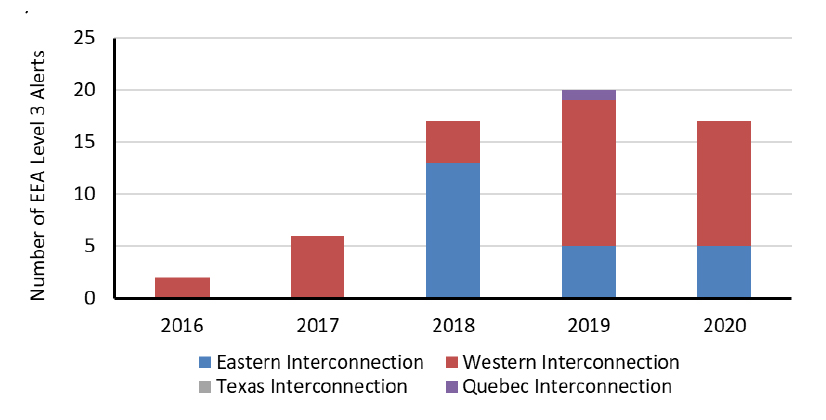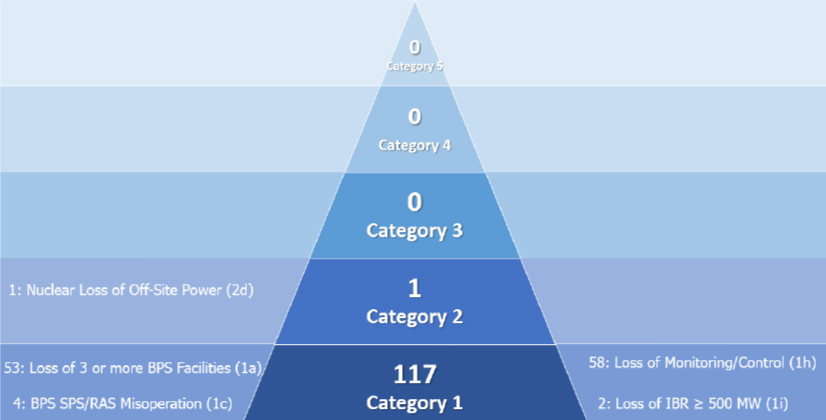The bulk power system recorded more than 22 hours of operator-initiated firm load shed in 2020, its highest level in five years and a reflection of the “unprecedented conditions” including extreme weather and cybersecurity that challenged grid operators, according to NERC’s 2021 State of Reliability Report, released on Tuesday.
In a media call announcing the report, John Moura — NERC’s director of reliability assessment and performance analysis — emphasized that “as unprecedented as it was, the BPS … remained reliable.” He pointed to the continuing decline in overall BPS events: As in 2019, there were no category 3, 4 or 5 events — unintended loss of load or generation of 2,000 MW or more — and only 118 qualified events overall, compared with 151 in 2019 and 180 the prior year. (See Resource Shifts Driving Grid Planning Changes.)
“The system didn’t experience any cascading instability or any widespread uncontrolled separation. That’s a good thing,” Moura said. “And key indicators show that fundamental day-to-day reliability operations are improving. We’re seeing better misoperation performance, better human performance; transmission [outage] severity [has] decreased, and we’re restoring systems faster.”
The number of level 3 energy emergency alerts (EEA3) also dropped to 17 from last year’s 20, breaking a four-year rising trend. Once again the Western Interconnection accounted for the greatest number of EEA3 events with 12, while the Eastern Interconnection reported five events, the same as last year. No EEA3s were reported for the Texas Interconnection — the same as last year — and for the Québec Interconnection, which reported one event in 2020.

However, while the amount of EEA3s dropped in 2020, they covered significantly more time than the previous year’s total: 54 hours in 2020 compared to 28 in 2019. Moreover, the largest load loss associated with an EEA3 in 2020 was 1,087 MW, compared to 150 MW in 2019, a measure surpassed by three more EEA3s in 2020.
Severe Weather Spurs Load Shedding
The report’s authors attributed the greatest fraction of the load loss in 2020 to just two extreme weather events, both in August: the arrival of Hurricane Laura in Louisiana, and the “intense and prolonged” heat wave across the Western Interconnection. NERC calculated that without these crises, the amount of time without operator-initiated firm load shed would have been closer to 99.95% of the year, the third-highest of the last five years after 2017 (100%) and 2019 (99.99%).
On Tuesday’s call Moura warned that the increase in load shedding will likely be even worse in next year’s report because of the impact of February’s winter storms that left thousands without power for days in Texas. (See ERCOT: Grid was ‘Seconds and Minutes’ from Total Collapse.) A number of causes have been associated with the grid’s failure in Texas, including an overall lack of preparedness for such extreme cold conditions and lower-than-expected performance across the generating fleet, including both renewable and conventional facilities.
“This is one of the metrics that, to me, matters the most, because at the end of the day, it’s really indicating that the system ran out of options: The operators had no more resources; the transmission system was unable to import anymore,” Moura said. “So I think it is indicative of some of the trends, both in how we’ve changed our resource mix very rapidly, but also how extreme weather is increasingly impacting the system.”
Because of the ongoing joint inquiry between FERC, NERC and the regional entities into February’s storms — a first draft of which is expected to be finished by Labor Day — NERC did not assess the event’s impact on BPS operations in this year’s report. (See NERC Provides Cold Weather, Cyber Updates.) However, authors said next year’s State of Reliability Report will include “an in-depth evaluation” of the storm’s effects.
In addition, this year’s Long-Term Reliability Assessment, expected in December, will “assess any longer-term reliability issues” raised by February’s crisis.
Praise for Industry Information Sharing
Cybersecurity continues to be a major concern in this year’s report. Although “there was no loss of load … from reportable cybersecurity incidents in 2020,” NERC noted that the number of cybersecurity incidents shared with the Electricity Information Sharing and Analysis Center (E-ISAC) nearly doubled, from 1,341 in 2019 to 2,624 in 2020.
A cybersecurity incident is defined as “an event that may negatively impact an organization and was noteworthy enough to report to the E-ISAC even if there were no outages or reliability impacts.” All categories of cyber incident saw an increase last year except for denial of service, which stayed the same at 17; malware, which dropped from 145 to 142; and miscellaneous, which fell from 25 to 13.

By contrast, multiple categories more than doubled, including ransomware (from 27 to 73), suspicious activity (453 to 956) and supply chain (39 to 85). Supply chain threats became a particular focus of concern in the last weeks of the year as news broke of the compromise of SolarWinds’ Orion network management software, which may have impacted nearly 18,000 SolarWinds customers and has since been attributed by law enforcement organizations to Russia’s Foreign Intelligence Service. (See FERC, E-ISAC Report Details Reach of SolarWinds Compromise.)
While the increase in reported incidents is a reminder of the rapidly evolving cybersecurity landscape, NERC also considers it a positive sign in the sense that the industry seems to be more comfortable sharing information with the E-ISAC.
“As the threat has grown, so too has the voluntary reporting of incidents to the E-ISAC, resulting in greater industry awareness,” the report says.
Pandemic Response Proves Successful
The industry response to the COVID-19 pandemic is another bright spot in the report, which notes that despite the sudden onset of the virus that required hasty adaptations on the part of many utilities, “there is no evidence” that it weakened reliability. Aside from “a limited number of equipment supply-related disruptions” that led to isolated generation outages and derates — none of which resulted in loss of load — there appears to have been no impact on the ability of utilities to continue serving customers.
“Regular industry-wide tabletop planning exercises anticipated the impacts of pandemic-like events years ago. They led directly to the development of and regular training for the emergency operating procedures that would be required,” NERC said. “The success of these efforts can be seen in the numbers. By the many measures reported in this report, there were no reductions in the overall reliability performance of the BPS that can be uniquely attributed to the pandemic. Instead, the overall reliability performance of the BPS was largely consistent with that in prior years.”




